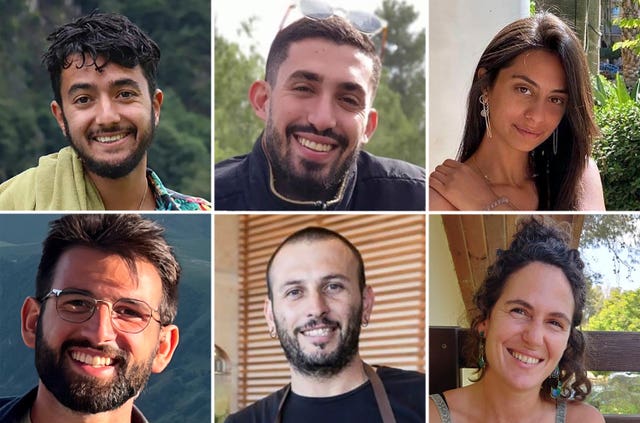Israel releases video of Gaza tunnel where it says militants killed six hostages
The video shows a low, narrow passageway deep underground that had no bathroom and poor ventilation.

The Israeli military has released video footage of a Gaza tunnel where it says six hostages were recently killed by Hamas.
The video shows a low, narrow passageway deep underground that had no bathroom and poor ventilation.
The discovery of the hostages’ bodies last month sparked a mass outpouring of anger in Israel and the release of the new video could add to the pressure on Prime Minister Benjamin Netanyahu to reach a ceasefire deal with Hamas to bring the remaining hostages home.
Israeli military spokesman Rear Admiral Daniel Hagari said on Tuesday the footage of the Gaza tunnel had been shown to the hostages’ families, and that it “was very hard for them to see how their loved ones survived in those conditions”.
Rear Admiral Hagari revealed the video in a nationally televised press conference after visiting the tunnel himself.
He said the tunnel was reached by a shaft buried under a child’s bedroom in a home in the southern Gaza town of Rafah.
The tunnel was about 20 metres (70ft) underground and stretched about 120 metres.
In the video, a hunched-over Rear Admiral Hagari, unable to stand upright in the narrow arched passageway, describes the conditions as extremely humid and difficult to breathe.

He showed bottles of urine, a bucket that appeared to have served as a makeshift toilet, a chess board and ammunition for an automatic rifle believed to have been used by the captors.
“They were here in this tunnel in horrific conditions, where there’s no air to breathe, where you cannot stand,” he said.
The six included Israeli-American Hersh Goldberg-Polin, 23, a native of Berkeley, California, whose parents led a high-profile global campaign seeking his release.
Mr Goldberg-Polin lost part of his left arm to a grenade in the October 7 attack that sparked the war in Gaza.
In April, Hamas issued a video that showed him alive, sparking protests in Israel.
The army identified the others as Ori Danino, 25; Eden Yerushalmi, 24; Almog Sarusi, 27; Alexander Lobanov, 33; and Carmel Gat, 40.

Three of the six – including Mr Goldberg-Polin – had reportedly been scheduled to be released in the first phase of a ceasefire proposal discussed in July, further fuelling anger when they were found dead.
The Hostages Families Forum, a group representing relatives of hostages, said in a statement that “time is running out” and called for an immediate deal to return those kidnapped.
“Every day that passes is a danger to their lives, hanging by a thread, at the mercy of terrorists capable of the worst crimes against humanity,” the group said.
Pathology tests on the bodies of the six, who were found by the military in the southern Gaza city of Rafah on Saturday, August 31, showed they had been killed sometime on the night of August 29, Rear Admiral Hagari told reporters.
Rear Admiral Hagari said Israeli soldiers found evidence indicating the hostages and at least two captors had been there for more than a few days.
Mattresses, clothes, assault rifle magazines and shells were also found, as was some food, mainly energy bars and tuna.
There were blood stains on the floor, he said.

Rear Admiral Hagari said the army had killed two militants trying to run away from a complex of tunnels on Friday near where the hostages were found and that there was “a probability” that the two had been those who killed the hostages.
DNA tests were being carried out to verify this, he added.
Hamas kidnapped about 250 people during the October 7 attack.
More than 100 were released during a brief ceasefire in November in exchange for the release of Palestinians imprisoned by Israel.
Eight have been rescued by Israeli forces, while Israeli troops mistakenly killed three Israeli hostages who had escaped captivity in December.
Israeli authorities say 101 hostages remain in captivity, including 35 who are believed to be dead.
Shai Dickman, the cousin of Ms Gat, one of the hostages who was found dead in the tunnel, told Israel’s Channel 13 TV that the government should move immediately to reach a deal to bring home the remaining hostages.
“There are still people living like this,” she said, holding back tears.
“If there had been a deal on time, Carmel would be sitting here.”
Hamas has offered to release the hostages in return for an end to the war, the withdrawal of Israeli forces from Gaza and the release of a large number of Palestinian prisoners, including high-profile militants.
But negotiations on a ceasefire have failed to produce any deal.





